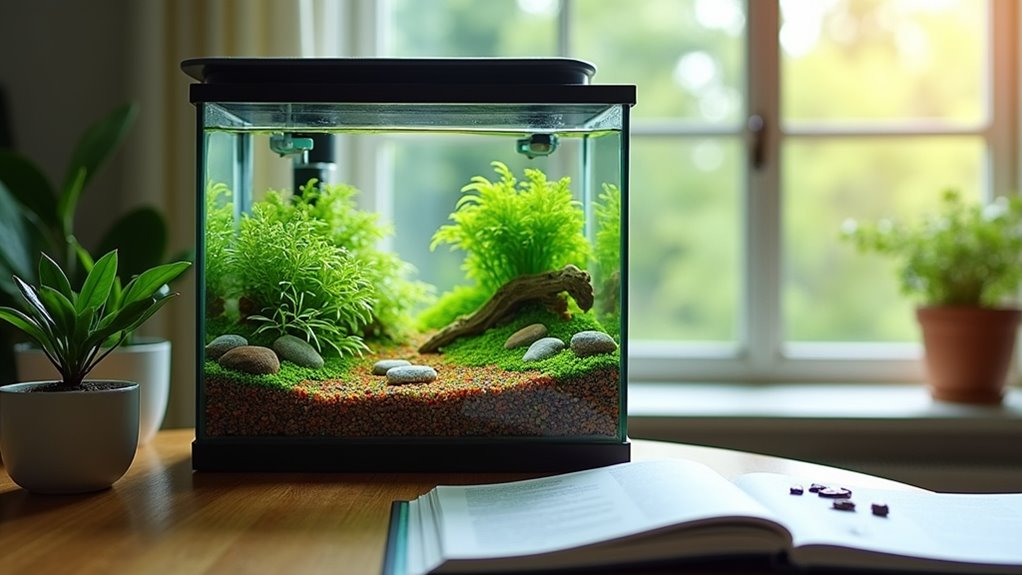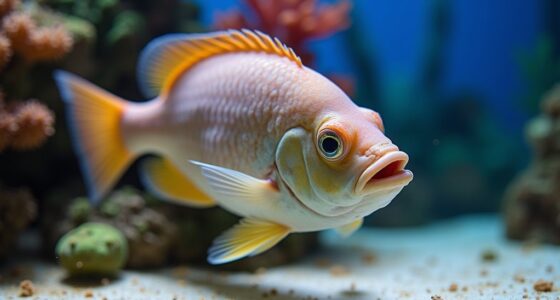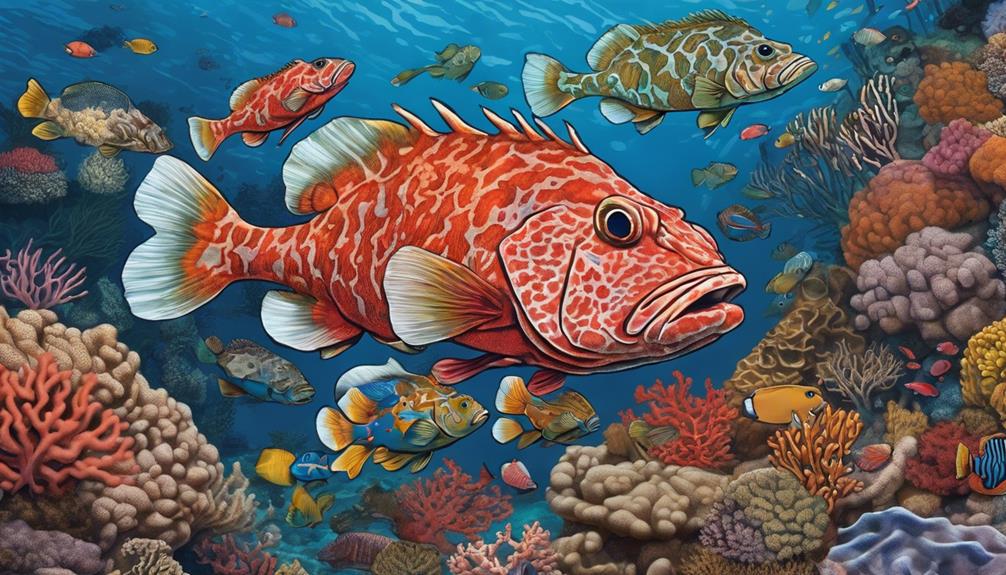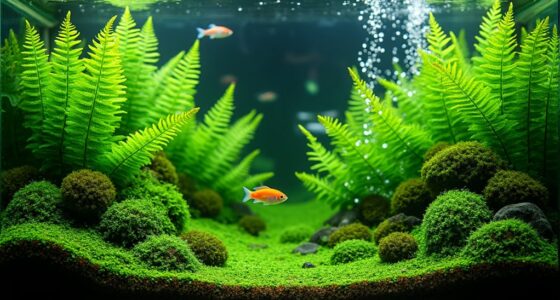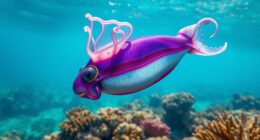Setting up your first aquarium begins with choosing the right filter for your tank size to guarantee proper water circulation and biological filtration. Install it correctly and regularly clean or replace media to maintain water quality and prevent toxins build-up. Keeping consistent maintenance, monitoring water flow, and supporting beneficial bacteria will create a healthy environment for your fish. Keep going, and you’ll discover how to create a thriving aquatic ecosystem step by step.
Key Takeaways
- Choose an appropriately sized tank and plan placement to avoid direct sunlight and drafts.
- Install a suitable filter to ensure proper water circulation and biological filtration from the start.
- Rinse all equipment and substrate thoroughly before setting up to prevent contaminants.
- Fill the tank with dechlorinated water and cycle it to establish beneficial bacteria.
- Regularly monitor water quality and perform maintenance to keep the environment healthy for fish.
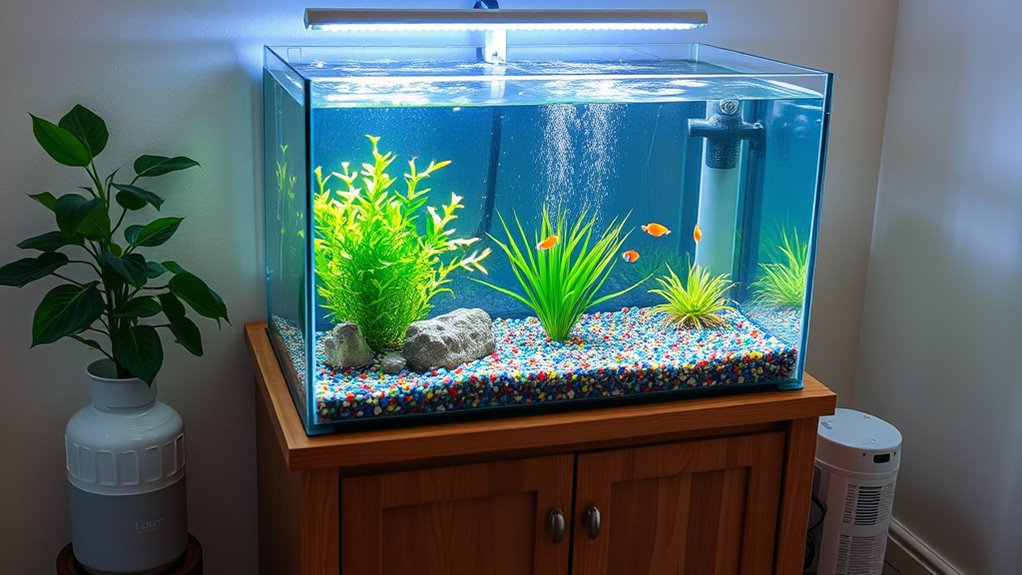
Starting your first aquarium can be an exciting project, but it also requires careful planning to guarantee a healthy environment for your fish. One of the most important aspects of setting up your tank is ensuring proper aquarium filtration. A good filter does more than just keep the water clear; it helps maintain a stable environment by removing toxins, excess food, and waste. As a beginner, you should look for a filter suitable for your tank’s size, with enough flow to circulate water effectively without creating strong currents that stress your fish. Consider options like sponge filters for smaller tanks or hang-on-back filters for larger setups, and always check the manufacturer’s recommendations for capacity. Installing and maintaining your filter correctly is essential. Regularly clean or replace filter media to prevent build-up and guarantee optimal performance. A well-functioning filtration system will keep your water healthy and your fish happy. Proper filtration also supports beneficial bacteria that are essential for biological balance in your tank, which is closely related to aquarium cycling and water quality. Additionally, understanding the importance of biological filtration can help you optimize your tank’s ecosystem for long-term health. Monitoring your filter performance ensures it operates efficiently and helps prevent issues before they become serious. Maintaining good water circulation is also crucial for preventing dead zones and ensuring even distribution of oxygen and nutrients throughout your tank.
Frequently Asked Questions
How Often Should I Test My Aquarium Water?
You should test your aquarium water regularly to maintain a healthy environment. The water testing frequency depends on your tank size and inhabitants, but generally, testing weekly is ideal. Use the best test kits to check ammonia, nitrite, nitrate, and pH levels. Consistent testing helps catch issues early, ensuring your fish stay healthy and your water stays clean. Adjust your testing schedule as your tank matures or if problems arise.
Can I Add Fish Immediately After Setting Up?
Imagine a calm, clear pond just after a gentle rain—your aquarium should be just as stable before adding fish. You shouldn’t add fish immediately after setup; instead, quarantine new fish and wait for ammonia and nitrite levels to stabilize. Live plants help, but a proper cycle is essential. Give your tank a few weeks, monitor water parameters, and guarantee a healthy environment before introducing your new aquatic friends.
What Are Common Beginner Mistakes to Avoid?
When starting out, avoid common beginner mistakes like overfeeding fish and neglecting water changes. Overfeeding can pollute your tank quickly, stressing your fish, while skipping regular water changes leads to poor water quality. Don’t rush to add fish immediately; give your tank time to establish beneficial bacteria. Monitor water parameters and feed sparingly. Staying attentive helps prevent issues and keeps your aquatic environment healthy and thriving.
How Do I Cycle My New Aquarium?
To cycle your new aquarium, you need to establish beneficial bacteria that convert harmful waste into less toxic substances. Start by adding a source of ammonia, like fish food or a small fish, to kick off the cycling process. Test your water regularly, and wait until ammonia, nitrite, and nitrate levels stabilize. This guarantees a healthy environment for your fish and prevents common beginner mistakes.
What Equipment Is Essential for a Beginner Aquarium?
Think of your tank like a well-oiled machine. You’ll need essential equipment like tank filtration to keep water clean and healthy, and aquarium lighting to mimic natural conditions. A reliable filter prevents toxins, while proper lighting helps plants and fish thrive. Don’t forget a thermometer for temperature control, and a basic kit with nets and water conditioners. With these essentials, you’re setting yourself up for a successful, vibrant aquatic world.
Conclusion
Starting your first aquarium is more than just setting up tanks and adding fish—it’s about creating a thriving, lively ecosystem. Many believe that fish simply add beauty, but in reality, they can teach us patience, responsibility, and the importance of balance. As you watch your aquatic world come to life, remember that nurturing this tiny universe can inspire confidence and wonder. Believe in your ability to care for it, and you’ll find joy in every ripple and bubble.
